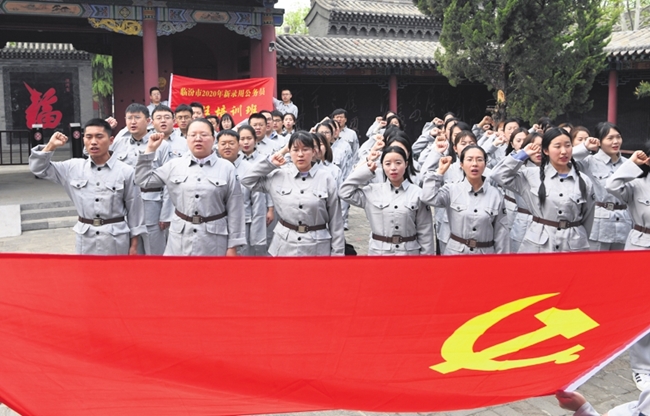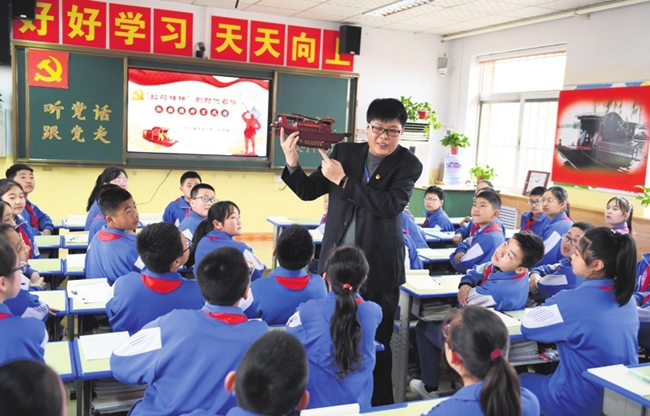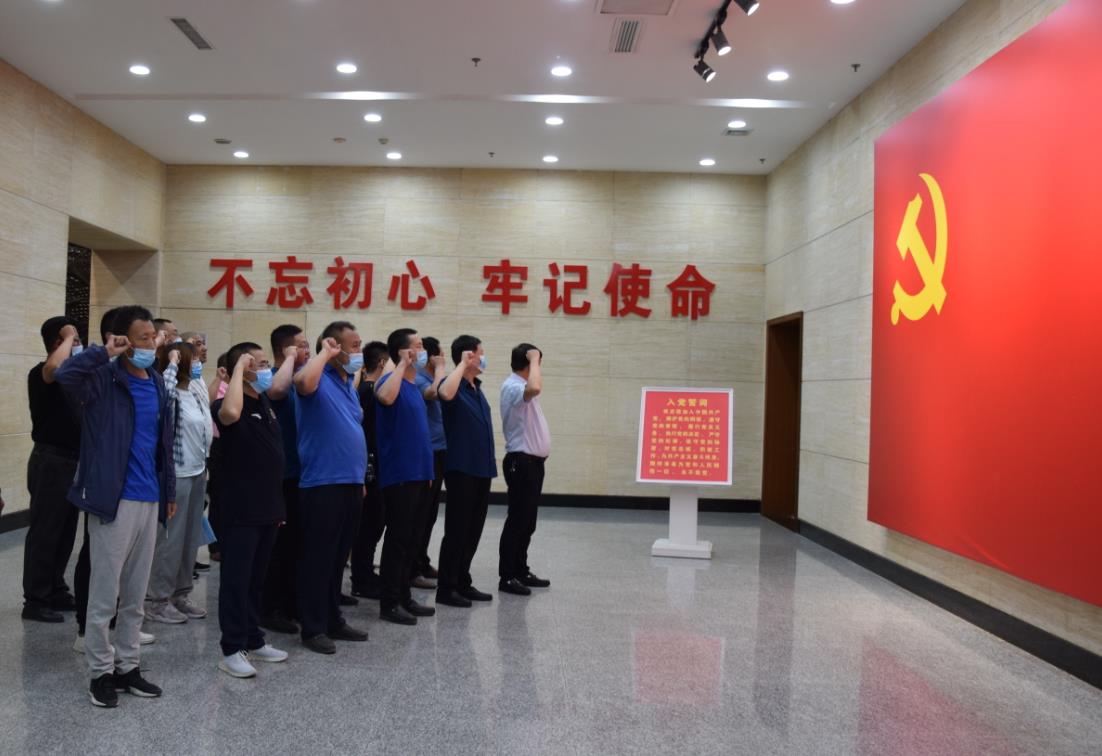
Party members in Linfen city attend a training session for the study of CPC history. LI HUWEI / FOR CHINA DAILY

A teacher in a primary school in Jishan county shows students a model of a boat that hosted a key Party meeting. LI LUJIAN / FOR CHINA DAILY
Studying the history of the Communist Party of China can remind officials and Party members of their missions, promote patriotism, increase coherence among citizens and inspire people to innovate, according to Party members and residents in North China's Shanxi province.
As this year marks the 100th anniversary of the founding of the CPC, Shanxi province has recently implemented a campaign to study and learn from the Party's history.
Since the beginning of this year, enthusiasm for studying CPC history has been increasing in governmental institutions, enterprises, schools and communities.
In late February and early March, special lectures and seminars featuring the Party's history were held in Shanxi's 85 higher-learning institutions and 7,807 primary and middle schools, marking the first lesson of their new semester.
In Taiyuan Normal University, for instance, the natural landscapes, local produce and folk traditions along the routes of the Long March (1934-36), have been newly included in lessons for students majoring in geography.
With a journey covering more than 10,000 kilometers, the Long March is the historic trek of the CPC-led Red Army, which resulted in the relocation of the Communist revolutionary base from the southeastern to the northern part of China, enabling the Red Army to fight the Japanese invaders on the front line.
"Throughout their journey, the communist troops overcame many difficulties, including crossing snow-covered mountains and torrential rivers, to reach the northwestern province of Shaanxi," a teacher at Taiyuan Normal University said.
"The heroism attributed to the Long March inspired many young Chinese to join the CPC during the late 1930s and early 1940s and will continue to inspire our contemporaries to make new achievements in the development of a modern China."
Soon after the Red Army arrived in Shaanxi, it reached neighboring Shanxi, a province that was closer to regions occupied by the Japanese aggressors.
After the nationwide War of Resistance Against Japanese Aggression broke out on July 7, 1937, Shanxi became the most important base for the CPC-led Eighth Route Army to fight the Japanese invaders.
The Taihang Mountains in the east of Shanxi witnessed many battles between the Eighth Route Army and the Japanese aggressors.
Today's Taihang is a major attraction among tourists because of many imposing sights including the cliffs rising perpendicularly from the valleys, which are often called the "iron walls of Taihang".
In the eyes of locals, the term "iron walls of Taihang" is not only a description of the landscape, but also a tribute to the heroes who protected the nation by pledging to "build a new Great Wall with their very flesh and blood".
General Zuo Quan (1905-42), deputy chief of staff of the army, honored the promise by sacrificing his life during a battle in the county of Liaoxian in 1942.
To pay homage to this great hero, the local people changed the name of the county to Zuoquan in the year of his death.
"More than seven decades ago, heroes like Zuo Quan devoted their lives to protecting the peace of our nation and safeguarding the wellbeing of our people," a local official said. "And today we still cherish the values as the most precious spiritual wealth."
The official said the local government and the Party committee of Zuoquan have put improving people's livelihoods high on their agendas.
"Our officials have paid frequent visits to the veteran soldiers and families of martyrs to address their concerns," the official said. "There are also special services offered to elderly people and free legal services and training for the laborers."
Pingxingguan in Lingqiu county is the site where the Eighth Route Army won its first decisive victory against the Japanese in September 1937.
The officials in Lingqiu take the same attitude in learning from the Party's history and cherish the same people-centered values as the officials in Zuoquan do.
"Improving the quality of life for our people, especially those in the rural areas, is a priority of our missions," an official from the Lingqiu county government said.
According to the official, the county government has invested heavily in projects improving the living environment for rural residents. These projects include garbage sorting and disposal facilities in 82 villages, 40 rural wastewater treatment plants and 48 rural public bathrooms.
Guo Yanjie contributed to this story.
By YUAN SHENGGAO
 山西路桥:党建引领 建好“四好农村路”山西路桥建设集团党委扎实开展“党建质量提升年”,实施“六大工程”,立足“十四五”高质量、高速度、高效益发展的战略基点,全面提高党建质量和党建引领发展水平,为打造“国内一流的交通基础设施投资、建设、施工现代化企业集团”提供坚强政治保障。
山西路桥:党建引领 建好“四好农村路”山西路桥建设集团党委扎实开展“党建质量提升年”,实施“六大工程”,立足“十四五”高质量、高速度、高效益发展的战略基点,全面提高党建质量和党建引领发展水平,为打造“国内一流的交通基础设施投资、建设、施工现代化企业集团”提供坚强政治保障。
 常住人口3491万 山西人口普查数据"出炉"山西省统计局向社会通报山西省第七次全国人口普查主要数据。数据显示,山西省常住人口为34915616人,比2010年(第六次全国人口普查数据,下同)减少2.23%,年平均减少0.23%。山西省常住人口总量减少,主要受人口流动变化等因素影响。
常住人口3491万 山西人口普查数据"出炉"山西省统计局向社会通报山西省第七次全国人口普查主要数据。数据显示,山西省常住人口为34915616人,比2010年(第六次全国人口普查数据,下同)减少2.23%,年平均减少0.23%。山西省常住人口总量减少,主要受人口流动变化等因素影响。